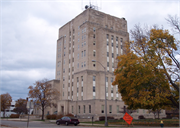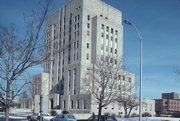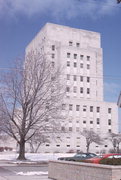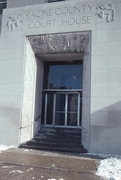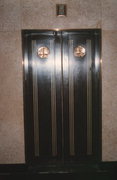Property Record
730 WISCONSIN AVE
Architecture and History Inventory
| Historic Name: | RACINE COUNTY COURTHOUSE |
|---|---|
| Other Name: | Racine County Courthouse |
| Contributing: | |
| Reference Number: | 11922 |
| Location (Address): | 730 WISCONSIN AVE |
|---|---|
| County: | Racine |
| City: | Racine |
| Township/Village: | |
| Unincorporated Community: | |
| Town: | |
| Range: | |
| Direction: | |
| Section: | |
| Quarter Section: | |
| Quarter/Quarter Section: |
| Year Built: | 1930 |
|---|---|
| Additions: | |
| Survey Date: | 1975 |
| Historic Use: | courthouse |
| Architectural Style: | Art Deco |
| Structural System: | |
| Wall Material: | Limestone |
| Architect: | Holabird and Root |
| Other Buildings On Site: | |
| Demolished?: | No |
| Demolished Date: |
| National/State Register Listing Name: | Racine County Courthouse |
|---|---|
| National Register Listing Date: | 7/28/1980 |
| State Register Listing Date: | 1/1/1989 |
| National Register Multiple Property Name: |
| Additional Information: | A 'site file' exists for this property. It contains additional information such as correspondence, newspaper clippings, or historic information. It is a public record and may be viewed in person at the Wisconsin Historical Society, Division of Historic Preservation. Builder was B-W Construction Co. TAPERED AT 1ST, 4TH, AND 10TH FLOORS. INTERIOR SCULPTURE BY CARL MILLES.The original cost of construction was $1.5 million dollars. Prominent Chicago architects Holabird and Root designed this eleven-story edifice, Racine’s most imposing landmark. With two low projections from its massive body, the courthouse looks a bit like a cubic sphinx. The symmetrical, stepped-back massing and vertical emphasis reflect the geometry of modernism. This building, stripped-down and solemn, includes only minimal ornamentation on its smooth Bedford limestone walls, with stylized leaves and shields at the roofline and stylized civic symbols capping the pilasters. But notice sculptor Carl Milles’ spectacular bas-relief panels in the entry plazas and recessed entryways, which adopt the heroic Social Realism style, popular in the 1930s; these depict people laboring, struggling through life stages, and grappling with nature’s elements. These panels were the internationally known Swedish immigrant’s first commission in the United States. The courthouse interior is equally impressive. Images of animals and wheat trim the entry doors; inside, geometric light fixtures illuminate the marble-lined lobby. The elevator doors--favorite decorative elements in the Art Deco vocabulary--are bronze, cast with figures of Agriculture and Industry. First-floor court rooms feature international hardwoods: Austrian and English oak, African and Mexican mahogany, American butternut, and walnut. Resurveyed November 2009; appearance unchanged. 2009: "This 11-story Art Deco building was constructed in 1930. The building is irregular in plan and is clad in limestone with low-relief sculptures decorating the facade. Windows are 1-over-1 double-hung. The building is tapered at the first, fourth, and tenth floors, and a 1-1/2 story entry bay projects from the center of the front (west) elevation; above the doorway, low-relief sculpture caps the words "Racine County/Court House."" |
|---|---|
| Bibliographic References: | Racine Landmarks Map Guide, 2003. HISTORIC 6TH STREET BUSINESS DISTRICT WALKING TOUR GUIDE, 1990 Buildings of Wisconsin manuscript. "Architecture/History Survey of 7th Street from 9th Street to Main Street in the city of Racine, WI. October, 2009. WHS Project #10-0922, Prepared by Gail Klein." Renewing Our Roots: A Guide To Racine, Wisconsin, Central City, Southside, Preservation-Racine, 1977. |
| Wisconsin Architecture and History Inventory, State Historic Preservation Office, Wisconsin Historical Society, Madison, Wisconsin |

